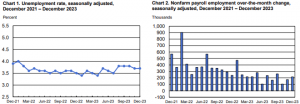January 5, 2024
In December, the U.S. Bureau of Labor Statistics reported a positive trend in total nonfarm payroll employment, showing an increase of 216,000 jobs. The unemployment rate remained steady at 3.7 percent. Job growth was observed in sectors such as government, health care, social assistance, and construction. However, the transportation and warehousing sectors experienced job losses during this period. The U.S. Bureau of Labor Statistics reported these findings based on two monthly surveys: the household survey, which assesses labor force status, including unemployment by demographic characteristics, and the establishment survey, which measures nonfarm employment, hours, and earnings by industry.

Household Survey Data
In December, the U.S. unemployment rate remained at 3.7 percent, with 6.3 million unemployed persons. Compared to the previous year, both the unemployment rate and the number of unemployed individuals were higher. Among the various demographic groups, the unemployment rate for adult men (3.5 percent), adult women (3.3 percent), teenagers (11.9 percent), Whites (3.5 percent), Blacks (5.2 percent), Asians (3.1 percent), and Hispanics (5.0 percent), showing minimal changes in December. The number of long-term unemployed (27 weeks or more) was stable at 1.2 million, accounting for 19.7 percent of all unemployed. The labor force participation rate and employment-population ratio each decreased by 0.3 percentage points to 62.5 percent and 60.1 percent, respectively. Part-time employment for economic reasons remained at 4.2 million, increasing by 333,000 over the year. The number of individuals not in the labor force but desiring a job rose to 5.7 million, up by 514,000 over the year. Among them, marginally attached individuals totaled 1.6 million, with discouraged workers at 346,000, both showing little change in December and over the year.
Establishment Survey Data
In December, total nonfarm payroll employment in the U.S. increased by 216,000 jobs. Job growth was notable in government (+52,000), particularly in local and federal government, health care (+38,000) with gains in ambulatory care and hospitals, social assistance (+21,000) focusing on individual and family services, and construction (+17,000), primarily in nonresidential building construction. However, the transportation and warehousing sector experienced a decline of 23,000 jobs, driven by losses in couriers and messengers. Employment in leisure and hospitality remained relatively stable (+40,000), and retail trade saw minor changes (+17,000), with notable gains in some subsectors offset by losses in department stores. Professional and business services showed modest growth (+13,000), with continued expansion in professional, scientific, and technical services but declines in temporary help services. Other major industries, including mining, manufacturing, wholesale trade, information, financial activities, and other services, demonstrated little change in employment during the month. Overall, in 2023, payroll employment increased by 2.7 million, with an average monthly gain of 225,000, a slower pace compared to 2022.
In December, average hourly earnings for all private nonfarm employees increased by 15 cents (0.4%) to reach $34.27, with a 4.1% rise over the past 12 months. For private-sector production and nonsupervisory employees, average hourly earnings grew by 10 cents (0.3%) to $29.42. The average workweek for all private nonfarm employees decreased slightly by 0.1 hour to 34.3 hours, while in manufacturing, it remained stable at 39.8 hours with no change in overtime hours. For production and nonsupervisory employees, the average workweek decreased by 0.1 hour to 33.7 hours.
Additionally, there were downward revisions in the total nonfarm payroll employment figures for October and November. The October figure was revised down by 45,000 jobs, from +150,000 to +105,000, and the November figure was revised down by 26,000 jobs, from +199,000 to +173,000. Consequently, the combined employment for October and November is now reported as 71,000 jobs lower than initially stated. These revisions are a result of additional reports from businesses and government agencies received since the last estimates, as well as the recalculation of seasonal factors.
Disclaimer:
Analyst Certification – The views expressed in this research report accurately reflect the personal views of Mayberry Investments Limited Research Department about those issuer (s) or securities as at the date of this report. Each research analyst (s) also certify that no part of their compensation was, is, or will be, directly or indirectly, related to the specific recommendation(s) or view (s) expressed by that research analyst in this research report.
Company Disclosure – The information contained herein has been obtained from sources believed to be reliable, however its accuracy and completeness cannot be guaranteed. You are hereby notified that any disclosure, copying, distribution or taking any action in reliance on the contents of this information is strictly prohibited and may be unlawful. Mayberry may effect transactions or have positions in securities mentioned herein. In addition, employees of Mayberry may have positions and effect transactions in the securities mentioned herein.
